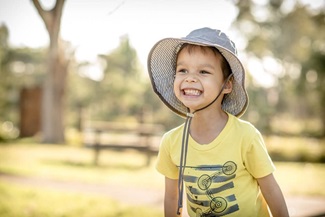Sun Safety: Tips to Shut Out the Sun's Rays
 Summer is heating up, and those little ones are itching to spend all day in the pool, at the beach or outside playing. But before you finish tying their shoes or putting on their swimsuit, you might want to grab some sunscreen and other forms of sun protection. Sunlight is the main source of UV rays, and too much exposure can put your kids at greater risk for skin cancer. According to the American Cancer Society, there are two types of UV rays that may contribute to the development of skin cancer:
Summer is heating up, and those little ones are itching to spend all day in the pool, at the beach or outside playing. But before you finish tying their shoes or putting on their swimsuit, you might want to grab some sunscreen and other forms of sun protection. Sunlight is the main source of UV rays, and too much exposure can put your kids at greater risk for skin cancer. According to the American Cancer Society, there are two types of UV rays that may contribute to the development of skin cancer:
- UVA: These rays are linked to long-term skin damage.
- UVB: These have slightly more energy than UVA and can damage your skin cells’ DNA. These are the rays that cause sunburns.
Here are a few things to think about when getting ready for some fun in the sun.
- Bring shade with you. UV rays are strongest between 10am and 4pm. If you’re going to be out during that time, bring a tent or umbrella to create shade, or find outside areas that have good shade.
- Dress for the occasion. Believe it or not, dark colors offer more protection than light ones. When applicable, dress in long sleeves or wear clothes that have a high ultraviolet protection factor (UPF). Dry wick clothing or fabrics that dry quickly offer more protection than clothes that stay wet. The same applies when kids are swimming. Use rash guards or swim shirts in addition to traditional bathing suits.
- Always accessorize. Hats and sunglasses aren’t just for looking cute. Hats should shade their face, head, neck and ears. Sunglasses should have flexible frames, but fit close to and cover the whole front of their eyes. Lenses should be 100 percent protective against UVA and UVB rays.
- Apply, absorb and repeat. Parents should use a broad-spectrum, water-resistant sunscreen with an SPF of 30 or more. Sunscreen should be applied 15-30 minutes before going outside and reapplied every two hours and right after swimming. Pediatrician, Dr. Alisa Pierce-Kee says many dermatologists are recommending mineral-based sunscreens. "I tell parents to look for the sunscreens with the highest concentration of zinc oxide—many of the brands make mineral based products now," she says.
Under 6 Months
Talk to your pediatrician about recommendations for sunscreen and sun protection products. Children under the age of 6 months should stay out of the sun and wear lightweight, protective clothing. If the use of sunscreen is necessary, the American Academy of Dermatology suggests a minimal amount of broad-spectrum, water-resistant sunscreen with an SPF of at least 30. Sunscreens containing titanium dioxide or zinc oxide are less likely to irritate a baby’s sensitive skin.
Watch the Clock
It can take as little as 15 minutes for UV rays to start damaging your skin. If you notice your child turning a little pink, get them in shade, cover them up and reapply sunscreen. If your child does get a sunburn, keep them hydrated and out of the sun. If you’re concerned with the severity of the burn, call your physician.
